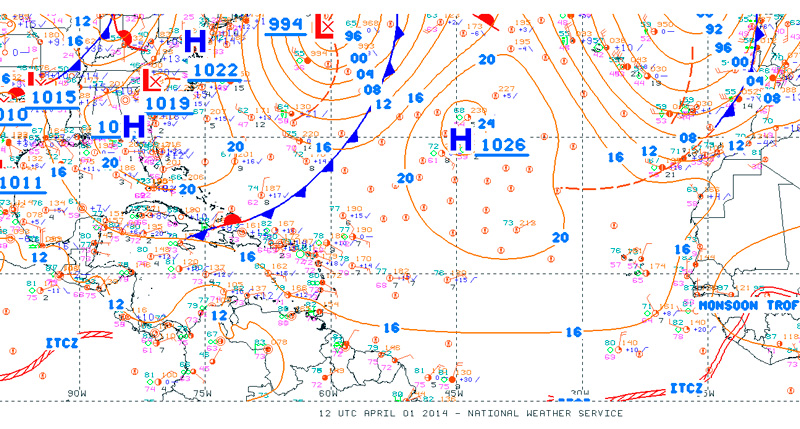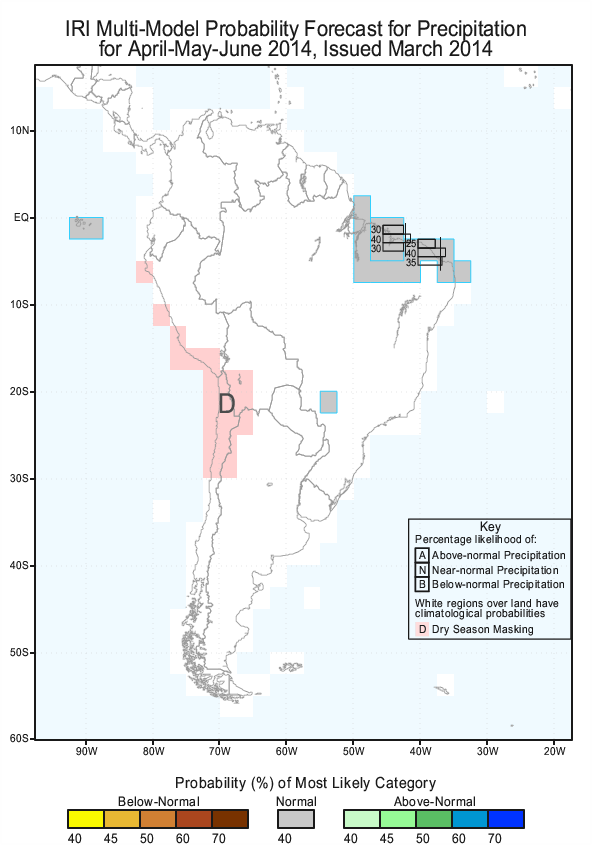| April 6, 2014 | No. 68 |
March 2014
The bottom line for the month of March is - generally dry. Here are the totals for March 2014 along with the totals for the entire year in the District of Boquete.
Rainfall for March & Year 2014 |
|||
Area |
Contributor |
Mar |
Year |
El Santuario |
Terry Zach |
1.35 |
3.58 |
Jaramillo Abajo |
Sela Burkholder |
0.14 |
0.56 |
Jaramillo Arriba |
Steve Sarner |
0.09 |
2.14 |
Los Molinos |
Fred Donelson |
0.43 |
0.69 |
Los Naranjos |
Craig Bennett |
1.05 |
1.74 |
Lucero (Cielo Paraiso) |
Michael Mullin |
0.40 |
0.79 |
Palmira Arriba |
Lloyd Cripe |
0.57 |
0.59 |
n/a = not currently available |
|||
The question on most people's minds is whether or not this year's dry season is dryer than normal and whether or not we are into some sort of drought? This is a challenging question.
To answer this question with a trend analysis, we need many years of weather data. Over the course of years there will be "normal" variations. Some dry seasons will be longer than others and have less rain than others. I have only been collecting weather data at the Palmira Station for 8 years so a formal trend analysis is not possible. It seems dry to me but I don't have enough data to determine if we are in some sort of drought trend.
Based on the rainfall data that I have for the months of March over 8 years, we had less rain this month than in previous years. Over the 8 years the mean rainfall for March has been 3.23 inches with a standard deviation of 2.30 inches. The range includes a low of 0.57 inches (this month) to a high of 7.09 inches (2009). I do not know if this is a trend, but I can say that we had the lowest rainfall this last month that I have seen in 8 years. Below is a chart summarizing the data for the month of March over 8 years.
There has been a significant high pressure area over the Caribbean due to the Jet Stream dipping south. This high pressure is the cause of our NE winds and it keeps the ITCZ from moving in over our area and dumping rain. When the high pressure decreases the wind will subside and the ITCZ will move over us with moist air and we will get rain.
Here is the Unified Surface Analysis Chart of the Caribbean on April 1, 2014. Note the very high pressure area (H 1026) over the Caribbean and our relatively low pressure area (L 1008). High pressure rushes to low pressure. Consequently we get NE winds under these conditions.

I have noticed the winds dying down a bit in recent days. When the winds subside (as all locals know), we will get rain. I think we will have rain shortly. Satellite images show moisture developing south of us along the ITCZ. It will soon happen.
Chile had a big 8.2 earthquake on April 1, 2014. There were Tsunami watches issued to include Panama. I don't think they materialized into anything significant but these watches and warnings are not to be ignored. If you want to read some interesting facts about past Tsunamis, check out this article.
We experienced a jolting earthquake here in the District of Boquete on April 4, 2014. I was visiting a friend in Volcancito overlooking Bajo Boquete when it struck at 11:13am. It really shook the house for about 15 seconds. Nothing was broken. As always it got our attention. The epicenter was 52km south of Pedregal (south of David area). You can read more here.
Check out the latest ENSO Cycle Report to see that we are still in a neutral condition. "ENSO-neutral is expected to continue through the Northern Hemisphere spring 2014, with about a 50% chance of El Niño developing during the summer or fall."You can get yourself educated as to what all of this means at this NOAA website. If you want to earn a graduate degree on the topic go here.
The IRI (International Research Institute for Climate and Society (select South America from the Region menu) is not reporting that we will have normal climatological precipitation probabilities for the months of April 2014 through June of 2014.

The Resplendent Quetzals have been nesting and displaying their best this month. If you haven't seen one of these beautiful creatures, you ought to get on the trails and catch a glimpse. Not easy but worth it. Here is a link to some recent photos along the Pipeline Trail. The male is hard to photograph because of the long tail and perching under the dark canopy. Some times I get lucky.
Enjoy the dry weather as long as possible, the cooling trade winds, the rock-and-roll of the earthquakes, and all the beautiful birds. Life is short but good in Paradise. Just don't become complacent and forget to keep the umbrellas handy for the soon to come rains. Shift happens!
Lloyd Cripe
